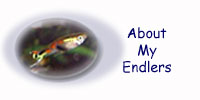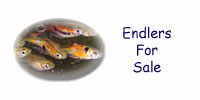
Two "Tuxedo" Male endlers, courting two females.
Breeding endlers is not difficult. If you put them together, they will breed. Males court the females constantly and will swim in front of them fanning their tails. Mating is usually quicker than can be observed but the males make repeated darts toward the female while showing off their colors and fins. Females sometimes get annoyed with the males and will chase them or nip them if they can catch them. I believe endlers are like guppies in that it seems like the female must swim in a certain pattern to allow the male to mate. Females are understandably most likely to become pregnant when fed well and in water above 70 degrees. They seem happy at 74-76 (as the trio on my desk at work can attest. They do not have babies often but when they do, there are many of them!).
It is much harder to prevent breeding and females should be separated as soon as gender can be determined (if you want to selectively breed them). My personal preference is to keep wild type endlers and as diverse of a population as possible. This means I allow free breeding and tend to only isolate unique males of a pattern that might die out without a little help. These "special males" are placed with virgin females. Usually, whatever pattern of male mates with a female, is the general color/pattern that the male offspring will be. I do keep small tanks of less common patterns to make sure they are present in my wild population as well as to guard against a massive die off like I had last time. I learned the hard way that that old adage is true...Do not put all your eggs or should I say endlers, in one basket (aquarium). It is a disaster waiting to happen if disaster strikes...whether disease, an overloaded heater or different water chemistry.
Young females have broods of 1-6 offspring on average. Full adult females have 10-15 on average but do occasionally have more if they are larger and well fed. It takes about a month for fertilized eggs to develop enough for a female to give birth. This process occurs this quickly only if the female is kept in an aquarium at 80-82 degrees. A few degrees less can mean a few more days in development time to weeks. Babies seem to be very strong and larger when incubated at lower temperatures. Those incubated at higher temperatures may not be quite a hardy but they rarely die and they usually go on to become productive adults. I usually keep my tanks around 76-78 since the fish burn out less quickly and die at an older age at this temperature. Endlers will still breed freely if kept at cool temperatures. My bath tub was probably 68-72 most of the time and I was still able to net out babies each week.
Feeding baby endlers is also easy, they will eat crushed flake food, fry food, and small live foods such as micro worms and baby brine shrimp. With good feeding and frequent water changes (if you have the time 50% of the water changed daily is not too much) you should be able to tell the boys from the girls at around 5-6 weeks on average. Some sex out sooner...others later. This depends on temperature, feeding and how good you are about water changes.





